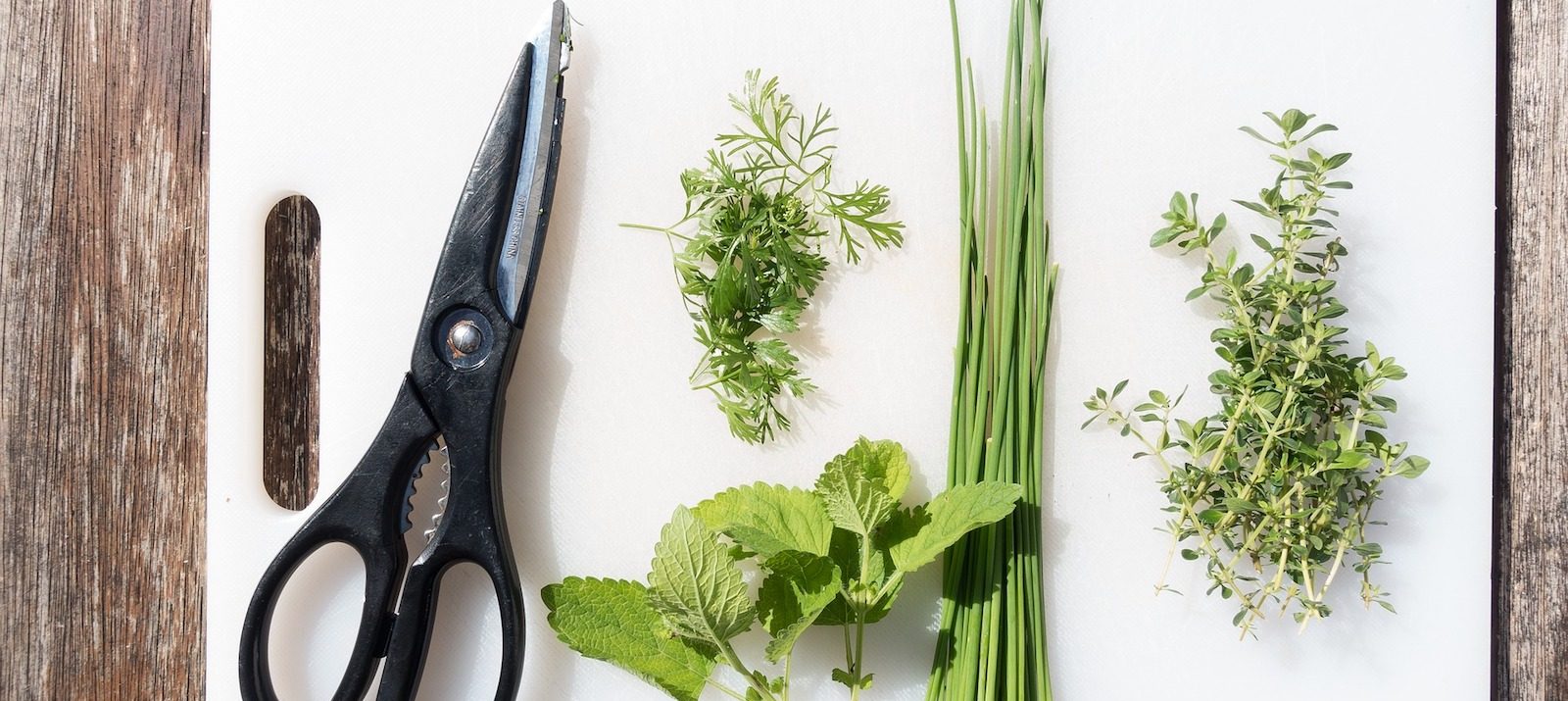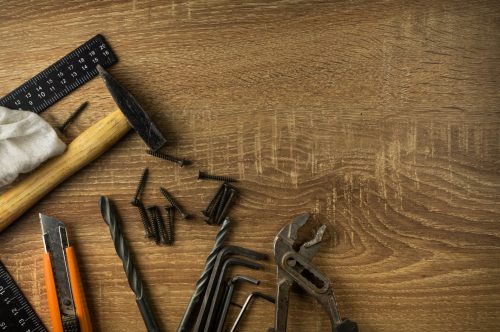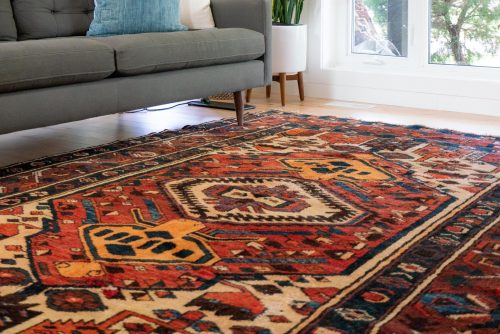When you move into a small city apartment, you let go of certain dreams:
- Pulling into a two-car garage every day after work
- Adopting a pack of Bernese mountain dogs
- Planting a perfectly manicured set of rosebushes
A full-on botanical garden might be impossible. Growing herbs indoors? Much easier to pull off.
This guide will teach you how to grow herbs indoors. You’ll master planting herbs in pots, caring for them, and harvesting your sage, cilantro, and basil when the time is right. Plus, you get to exercise your green thumb and improve your home cooking.
You may have to make a few trips to Home Depot, but your stomach will thank you.
Learn more: 12 At-Home Spring Activities to Uplift Your Mood
Seamless Moving, Secure Storage—Let Us Simplify Your Transition!
Tips on how to grow various types of herbs
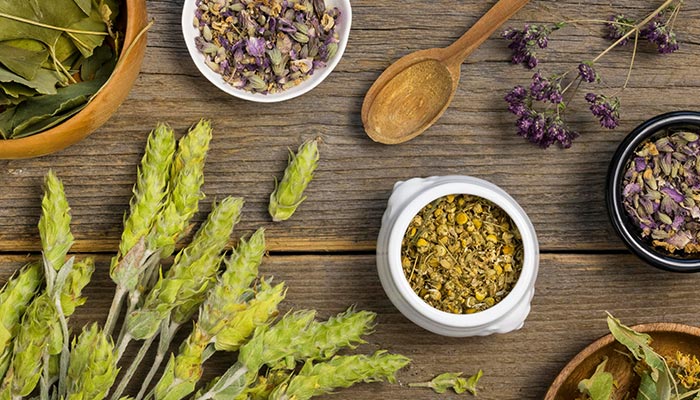
- Choose the Right Herbs: Start with easy-to-grow herbs like basil, mint, or parsley. These herbs thrive indoors and require minimal care. Selecting herbs that suit your cooking needs and available space makes the process more enjoyable.
- Find the Perfect Spot: Herbs love sunlight, so place them near a south-facing window. If natural light is limited, consider using grow lights to ensure they get at least 6 hours daily.
- Use the Right Containers: Choose pots with good drainage to prevent waterlogging. Herbs don’t like “wet feet,” so containers with holes at the bottom are essential. You can even get creative with containers to match your apartment’s style.
- Water and Feed Regularly: Keep the soil moist but not soggy. Herbs need consistent watering, especially during dry indoor conditions. Use a liquid fertilizer every few weeks to keep your herbs lush and healthy.
- Prune for Growth: Regularly trim your herbs to encourage bushier growth. This keeps them healthy and gives you fresh herbs for cooking. Pinch off the tops of the plants to prevent them from flowering, as flowering can make herbs taste bitter.
Learn more: How to Grow Your Own Edible Garden
Click any of the links below to jump to a specific section:
Indoor Herb Gardening Basics
How To Grow Basil
How To Grow Mint
How To Grow Rosemary
How To Grow Oregano
How To Grow Thyme
How To Grow Sage
How To Grow Parsley
How To Grow Cilantro
Indoor Herb Gardening Basics
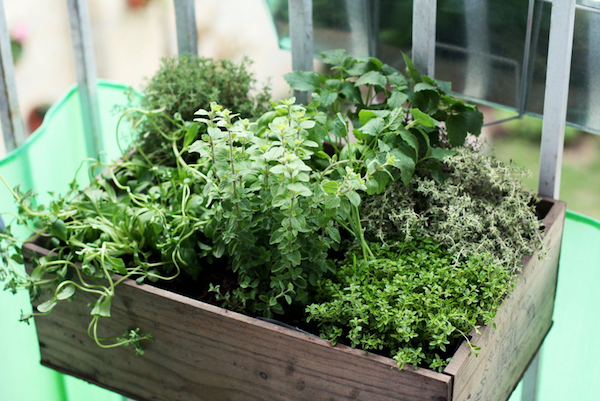
Selecting a spot for your new indoor herb garden is the most important part of the process. The plants need a place where they can get six hours of sunlight each day.
A kitchen windowsill is a great option. But as Planet Natural advises, a corner with two windows — one that faces south and one that faces west — is the best case scenario.
Have an apartment with minimal natural light?
Bump up the brightness with some fluorescent or high-intensity discharge (HID) lights, available at home improvement stores.
Learn more: 7 Easy Ways To Fill Your Apartment With Natural Light
Your pots should be at least eight inches in diameter — for certain herbs, even larger pots are better. And when shopping for soil, don’t make the rookie mistake of picking up garden soil. It’s too heavy for pots and not formulated for the plants that grow inside them. Get a high-quality potting mix instead.
While it’s fine to use soil straight from the bag, mixing in some compost (for added nutrients) and coarse sand (for better drainage) can work wonders.
It’s important to water your plants, but don’t go overboard. Overwatering can lead to root rot, so try to hit a happy medium. The rule of [green] thumb is to water when the soil feels dry an inch below the surface. Also, use pots with drainage holes.
Three more important pieces of advice:
- Make sure to label each of your plants.That way, you won’t accidentally add cilantro to your pesto sauce.
- Once the herbs mature, harvest carefully. Taking more than a third of the plant at once makes it harder for the plant to recover and produce new herbs.
- When it is time to harvest, do it in the morning. According to Modern Farmer, the midday sun saps the essential oils out of herbs, so it’s best to grab them while they’re still full of flavor.
So what are the best herbs to grow indoors?
Here are a few of the most common herbs, and what it takes to make each of them thrive.
Learn more: 6 Tips for Urban Gardeners with Limited Space
How To Grow Basil
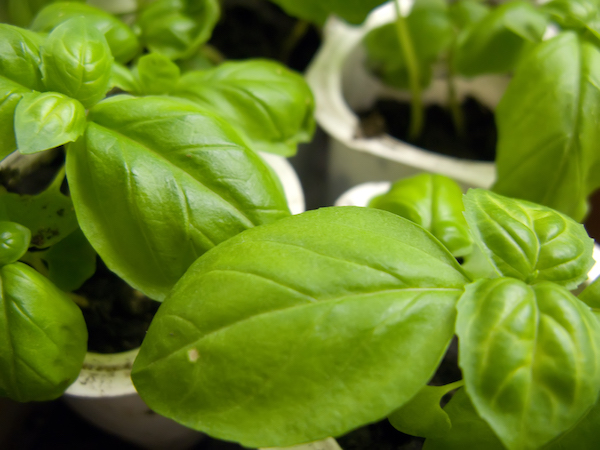
Basil is an herb garden no-brainer. You can use it in pastas, salads, pizzas, sauces, and so much more. Plus it’s very easy to cultivate at home.
Basil requires a medium-sized pot, since it usually grows to between 12-24 inches in height. Fill the pot up about 3/4 of the way with soil and lightly water it.
Then it’s time to add your seeds. The New York Restoration Project recommends spacing the seeds 2-3 inches apart on top of the soil. Once they’re settled, cover them with the remaining 1/4 of soil.
You’ll need to space your seedlings even further apart after they’ve had a chance to grow. Every now and then, snip off the tips of the plant to encourage the basil to branch out. Also, keep an eye out for flowers. You should cut those before they bloom.
As soon as your plant is in tip-top shape, pick leaves individually to suit your recipes.
How To Grow Mint
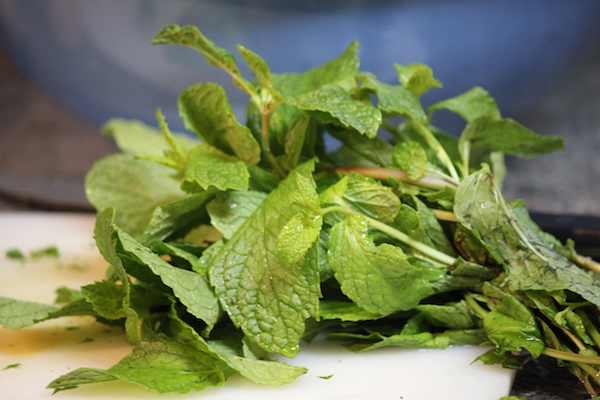
Mint is a sprawling plant, so take extra precautions to keep it contained. The first thing you’ll need to pull this off is a large, deep pot. Use one that’s 12-16 inches wide.
The Kitchn suggests you skip the seed stage and start with a more mature piece of mint. If you have a friend who’s already growing buckets of the stuff, ask him or her to cut you off a root.
Don’t have a pal with a green thumb?
Head to the farmers’ market and pick up a sprig. You can set that in a glass of water near the window and, once the roots emerge, transfer it to the pot.
Since mint grows like crazy, stay on top of your harvesting. You can pick leaves as you need them, like basil. Or your can reap most of the bounty at once by cutting the leaves at the stems. If you’re doing the latter, make sure to harvest before the whole plant flowers.
How To Grow Rosemary
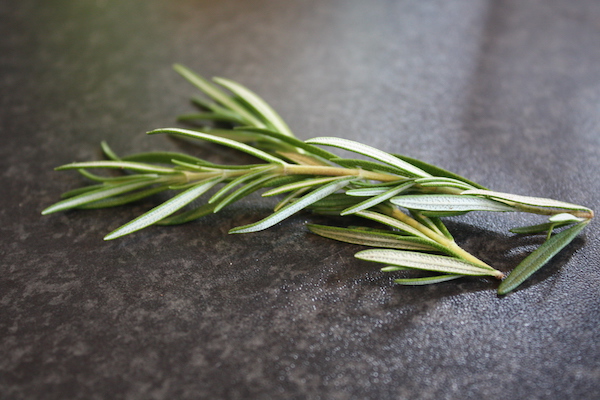
Don’t be a hero and try to grow this stuff from seed. Rosemary is very difficult to germinate. Many seeds don’t take at all, and the ones that do take their sweet time.
That’s why Gardening Know How suggests buying a small bedding plant from your local nursery. Make sure it doesn’t have any powdery mildew on it before you purchase.
Set your plant up in a pot at least 12 inches wide. Rosemary hates the cold, so put it close to sunlight. Also, don’t crowd it with too many other plants.
Because rosemary is a bit tougher than some of the other herbs on this list, you’ll need clippers to harvest it. You can take quite a bit at a time, but don’t cut the stems too low or it’ll take longer for the plant to regrow.
Although you can use fresh rosemary, eHow expert Jarrett Mann says it tastes better dried and stored:
To dry your rosemary, bundle up the sprigs and set them in a dry space like an attic or your oven. (The Kitchn suggests placing it on a parchment paper-lined baking sheet, then turning the oven onto the lowest setting.) Then, you can pull off the leaves and crumble them into a jar. Alternatively, you can pluck off all the leaves and freeze them in a Ziploc bag for later use.
How To Grow Oregano
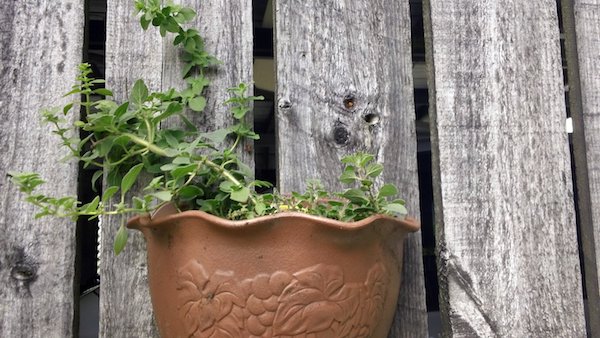
Although oregano can be grown from seeds or root cuttings, cuttings are much easier on first-timers. After you’ve set your oregano up in a pot that’s about 12 inches in diameter, keep an eye out for flower buds. As with basil and mint, those signal it’s time to harvest.
If you’re taking a big batch of oregano rather than a few leaves for your dinner recipe, cut by the stem and then hang the bunches to dry. Once dry, pick the leaves off the stems and seal them up for storage.
How To Grow Thyme
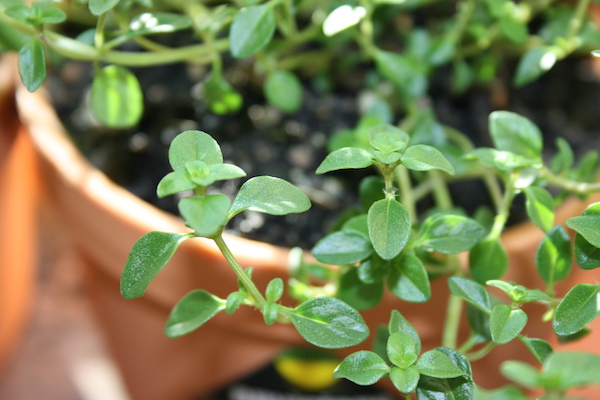
According to The Old Farmer’s Almanac, thyme seeds are tough to grow because of their slow, uneven germination. So it’s much less of a headache to start with a seedling that’s already bypassed the early stages of growth.
Water thyme frequently, and cultivate it in a sandy soil mix. When it’s grown, thyme is super simple to harvest. Just snip off whatever you want, leaving several inches on the stem so it doesn’t slow down.
If you want to use thyme fresh, grab the leaves off the stem and crumble them slightly before adding them to your recipe. If you want to use it later, hang the stems up to dry in a cool, dark spot and then pack them into glass jars.
You can also freeze thyme, though maybe not in the same way that Time Lords do. For more info, refer to Crafty’s guide on how to grow thyme indoors.
How To Grow Sage
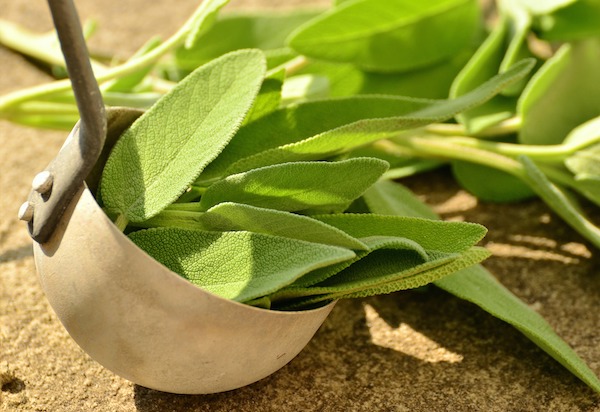
The next stop on our tour of Simon and Garfunkel’s “Scarborough Fair” garden is sage. This herb can grow up two feet tall and two feet wide, so make sure you start with a big pot.
Balcony Container Gardening recommends you keep your soil fairly dry, and supplement with fertilizer once a month during growing season.
Sage can acquire a “woody” quality after your plant hits the three or four year mark, so take cuttings while it’s in its prime. That way, you can cultivate new specimens before the current one hits retirement.
You can harvest sage leaves as you need them. But if you want to help your plant reach its highest potential, do at least two bigger hauls during its growing season. This will make the plant more rounded, and the leaves more plentiful.
How To Grow Parsley
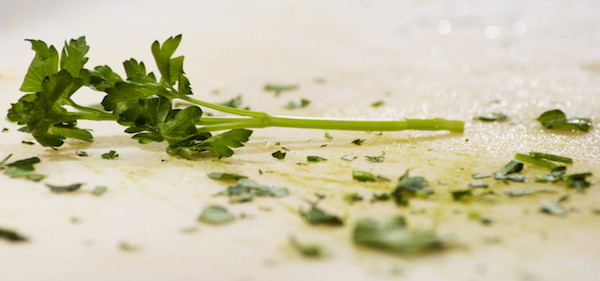
There are actually two types of parsley: curly leaf and flat leaf.
Curly leaf is much easier to chop, but flat leaf (also called Italian parsley) has a bolder flavor to it. Decide which one is best suited to your culinary needs before you proceed.
On the Green Farms recommends you grow your parsley in a gallon-size pot with a minimum depth of eight inches. It’s fine to use several seeds, since parsley has a low germination rate.
When do you harvest parsley?
Once your plant is producing leaf stems with three branches. The plant should be about six inches tall by that point. Simply take a stem or two from the lower branches to start and then build as the plant continues to grow.
While you can keep parsley going for two years before it taps out, know that the second-year yield will probably be more bitter than the first.
How To Grow Cilantro
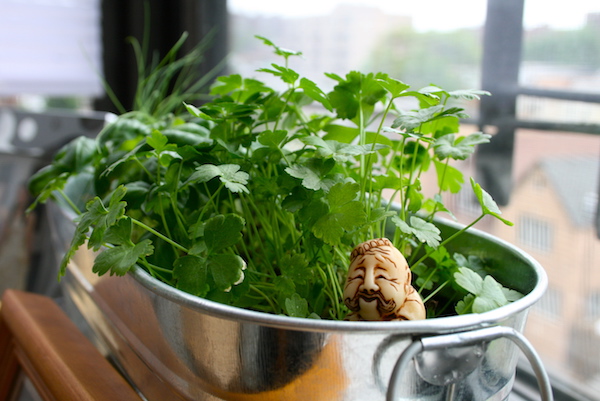
Anyone who loves guacamole (aka everyone) needs a steady stream of cilantro in their lives. This is easy to achieve. It begins with coriander seeds.
Coriander and cilantro are often used interchangeably, but there’s a slight distinction. Coriander refers to the seeds, while cilantro is the term for the plant those seeds produce. According to Den Garden, coriander has a high germination rate, so don’t plant too many in your container. Go for a medium-to-large pot, since cilantro roots run 19-23 inches deep.
The first couple leaves will look long and plain, and sometimes they stick to the seed. Don’t panic, that’s normal. Let the leaves be. The plant will straighten itself out.
When the leaves are ready to reap, it’s best to pick and use them ASAP. Unlike many other herbs, cilantro does not dry or freeze well. So get it in that guac, stat.
Clear room for your herbs with MakeSpace
It might start with a simple basil plant. But once you’ve got some thyme, oregano, and parsley in the mix, you’re going to need extra sill space for your thriving herb garden.
So what should you do with the oversized appliances or accessories that have been displaced by your sage bush?
That’s easy. Send them to MakeSpace.
After you’ve scheduled a pickup (your first pickup is free!), we’ll pick up your stuff and transport it to our secure temperature-controlled storage facility. We’ll also create an online photo catalog of your stuff so you always remember what you have in storage.
The best part:
When you want something back from storage, log into your Clutter account, select the item’s photo, and we’ll deliver it to you.
Maintaining fresh mint might not be easy, but storage has never been simpler.
Benefits of Growing an Herb Garden in Your Apartment
1. Fresh Herbs at Your Fingertips:
Benefit from the comfort of having fresh, flavor-filled herbs that are easily accessible for cooking in your house.
2. Cost Savings:
Cultivating your herbs is an extra way for you to save on the food budget if you buy store-bought herbs, mainly if you buy them haphazardly.
3. Enhances Air Quality:
For example, mint and basil plants smell very pleasant. They also help clean the air in your apartment, which will make it the healthiest home you will have.
4. Adds Greenery to Your Space:
Installing a small herb garden in your apartment will make it prettier and more natural-looking. Herbs can brighten the space and make it more associated with nature.
5. Therapeutic and Stress-Relieving:
Taking care of your herbs is a refreshing activity that can help lower stress levels and enhance mental health.
Learn more: 19 Best Backyard Storage Ideas, Tips & Hacks You Need To Try
Tips for Selecting the Perfect Containers
1. Size Matters:
Pick containers big enough for good herb development but small enough to fit your space requirements.
2. Drainage is Key:
Make sure your pots remain well-drained. Otherwise, water won’t pool at the bottom, promoting root rot.
3. Material Considerations:
Clay is a breathable and excellent material for potting herbs, but it loses moisture faster, so it is better to prefer plastic when you are a frequent waterer.
4. Mobility:
If you want to move your plants to different windowed areas throughout the day, opting for lightweight containers or those with handles is a good idea.
5. Style and Aesthetics:
Your containers become an intrinsic part of your decoration. Choose the ones that match your apartment’s style and jazz up your indoor garden by introducing a personal element.
Finding the Right Location in Your Apartment
1. Maximize Sunlight:
Station your herbs near a south-facing window so that the lumens will reach the desired levels. Nevertheless, if you are in a no-sun condition, bring in additional grow lights.
2. Avoid Drafts:
Moreover, do not keep your herbs near cold drafts or even source heaters like radiators since these can cause the plants to suffer.
3. Use Vertical Space:
If there isn’t much floor space, consider the wall area an option—use shelves or hanging baskets to create a garden with limited space.
4. Easy Access:
Place your herb garden in an easily accessible location, such as the kitchen, so you can cook and pick fresh herbs to boost your dish’s taste.
5. Group Based on Needs:
Herbs with similar light and water needs should be grouped to simplify management and reduce your time on plant care.
Planting and Caring for Your Herb Garden
– Planting:
Begin by filling your container with a top-quality potting mix. Sow seeds or set seedlings according to the instructions on the packet. Make sure that every plant has enough space among neighbors to grow fully.
– Watering:
Herbs require constantly moist soil but prefer to avoid getting waterlogged. To check the dryness level, touch the first inch of the soil. Avoid touching the second one, which could cause the root rot.
– Fertilizing:
To help your herbs thrive, you must water them with liquid fertilizer every two to three weeks. Organic fertilizers will help you maintain their natural quality and are safe to use when cooking.
– Pruning:
Regularly trim your herbs to encourage bushy growth. Pinching off the tips of the stems will prevent the plants from flowering and keep the leaves tender and flavorful.
Managing Pests and Preventing Diseases
Keeping your indoor herb garden healthy means being proactive about pests and diseases. Regularly inspect your plants for signs of pests like aphids or spider mites.
If you notice any, remove them by hand or use a gentle soap solution. Good air circulation is key to preventing fungal diseases, so avoid overcrowding your plants.
Also, avoid overwatering, as soggy soil can lead to root rot and other issues. If you catch any problems early, they’re much easier to manage.
Seamless Moving, Secure Storage—Let Us Simplify Your Transition!
Harvesting and Using Your Herbs
Once your herbs have grown, it’s time to enjoy the fruits of your labor. Harvest your herbs by cutting them just above a leaf node, encouraging new growth.
Use fresh herbs in your cooking for maximum flavor. You can also dry or freeze them to preserve their goodness for later use.
There’s nothing quite like the satisfaction of seasoning your dishes with herbs you’ve grown yourself!
Conclusion
Growing an herb garden in your apartment is possible and incredibly rewarding. With the right setup and care, you can enjoy fresh, home-grown herbs year-round, no matter how small your living space is. It’s a great way to add flavor to your meals, improve your environment, and experience the joys of gardening right in your own home. So why not start your indoor herb garden today? Your future self will thank you!
FAQs for How to Grow Different Types of Herbs
Q: Is growing herbs in a small apartment with no outdoor space feasible?
A: Absolutely! Even without a balcony, you can grow herbs indoors by placing them near a sunny window or using grow lights to provide the necessary light. Choose compact varieties that thrive in small spaces, and you’ll have a flourishing herb garden right inside your apartment.
Q: How can I keep my herbs from getting too tall and spindly in low light?
A: To prevent your herbs from becoming leggy in low light, consider supplementing natural light with grow lights. Additionally, rotate your plants regularly so that all sides receive even light exposure, and pinch back the stems to encourage fuller, bushier growth.
Q: Can I start an herb garden using scraps from my kitchen?
A: Yes, many herbs can be regrown from kitchen scraps! For example, you can regrow basil, mint, or green onions by placing the cut stems in water until roots develop, then transferring them to soil. It’s an eco-friendly way to start your indoor herb garden.
Q: How can I keep mold or mildew from forming on my herbs in a humid environment?
A: To prevent mold or mildew, ensure your herbs are in well-draining pots and avoid overwatering. Increase air circulation around your plants by placing them in a well-ventilated area or using a small fan. Also, remove any dead or decaying leaves promptly to reduce the risk of fungal growth.
Q: What’s the best method for fertilizing herbs in a limited space?
A: In a small apartment, it’s best to use a diluted, balanced liquid fertilizer every 4-6 weeks. This will provide your herbs with the nutrients they need without overwhelming them. Organic fertilizers are a great option for keeping your herbs safe and chemical-free.
Maintaining fresh mint might not be easy, but storage has never been simpler.


